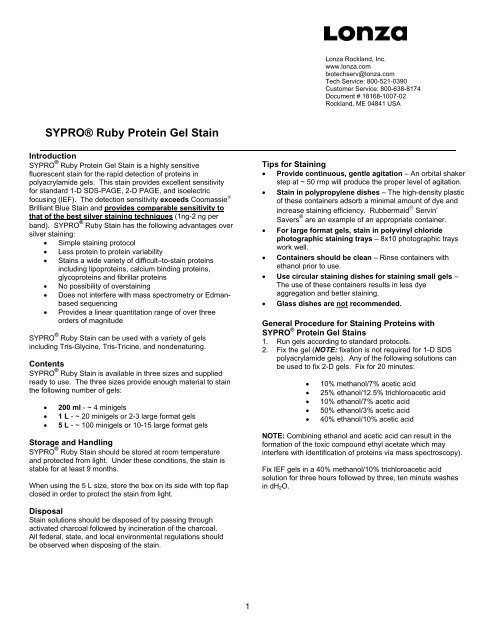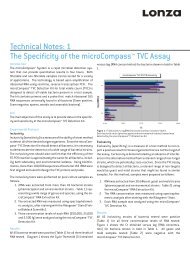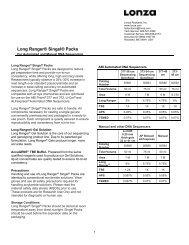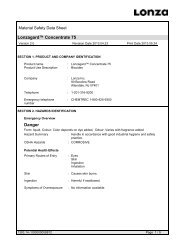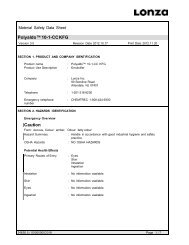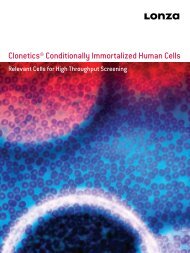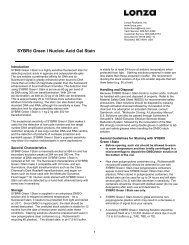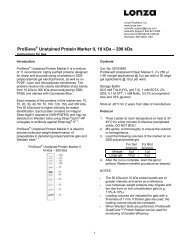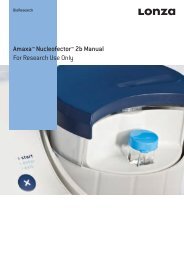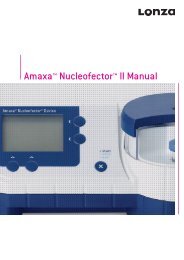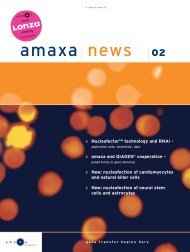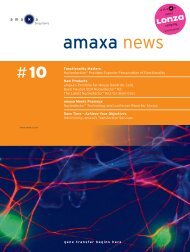SYPRO® Ruby Protein Gel Stain - Protocol
SYPRO® Ruby Protein Gel Stain - Protocol
SYPRO® Ruby Protein Gel Stain - Protocol
You also want an ePaper? Increase the reach of your titles
YUMPU automatically turns print PDFs into web optimized ePapers that Google loves.
<strong>SYPRO®</strong> <strong>Ruby</strong> <strong>Protein</strong> <strong>Gel</strong> <strong>Stain</strong><br />
Introduction<br />
SYPRO ® <strong>Ruby</strong> <strong>Protein</strong> <strong>Gel</strong> <strong>Stain</strong> is a highly sensitive<br />
fluorescent stain for the rapid detection of proteins in<br />
polyacrylamide gels. This stain provides excellent sensitivity<br />
for standard 1-D SDS-PAGE, 2-D PAGE, and isoelectric<br />
focusing (IEF). The detection sensitivity exceeds Coomassie ®<br />
Brilliant Blue <strong>Stain</strong> and provides comparable sensitivity to<br />
that of the best silver staining techniques (1ng-2 ng per<br />
band). SYPRO ® <strong>Ruby</strong> <strong>Stain</strong> has the following advantages over<br />
silver staining:<br />
• Simple staining protocol<br />
• Less protein to protein variability<br />
• <strong>Stain</strong>s a wide variety of difficult–to-stain proteins<br />
including lipoproteins, calcium binding proteins,<br />
glycoproteins and fibrillar proteins<br />
• No possibility of overstaining<br />
• Does not interfere with mass spectrometry or Edmanbased<br />
sequencing<br />
• Provides a linear quantitation range of over three<br />
orders of magnitude<br />
SYPRO ® <strong>Ruby</strong> <strong>Stain</strong> can be used with a variety of gels<br />
including Tris-Glycine, Tris-Tricine, and nondenaturing.<br />
Contents<br />
SYPRO ® <strong>Ruby</strong> <strong>Stain</strong> is available in three sizes and supplied<br />
ready to use. The three sizes provide enough material to stain<br />
the following number of gels:<br />
• 200 ml - ~ 4 minigels<br />
• 1 L - ~ 20 minigels or 2-3 large format gels<br />
• 5 L - ~ 100 minigels or 10-15 large format gels<br />
Storage and Handling<br />
SYPRO ® <strong>Ruby</strong> <strong>Stain</strong> should be stored at room temperature<br />
and protected from light. Under these conditions, the stain is<br />
stable for at least 9 months.<br />
When using the 5 L size, store the box on its side with top flap<br />
closed in order to protect the stain from light.<br />
Disposal<br />
<strong>Stain</strong> solutions should be disposed of by passing through<br />
activated charcoal followed by incineration of the charcoal.<br />
All federal, state, and local environmental regulations should<br />
be observed when disposing of the stain.<br />
1<br />
Lonza Rockland, Inc.<br />
www.lonza.com<br />
biotechserv@lonza.com<br />
Tech Service: 800-521-0390<br />
Customer Service: 800-638-8174<br />
Document # 18168-1007-02<br />
Rockland, ME 04841 USA<br />
Tips for <strong>Stain</strong>ing<br />
• Provide continuous, gentle agitation – An orbital shaker<br />
step at ~ 50 rmp will produce the proper level of agitation.<br />
• <strong>Stain</strong> in polypropylene dishes – The high-density plastic<br />
of these containers adsorb a minimal amount of dye and<br />
increase staining efficiency. Rubbermaid ® Servin’<br />
Savers ® are an example of an appropriate container.<br />
• For large format gels, stain in polyvinyl chloride<br />
photographic staining trays – 8x10 photographic trays<br />
work well.<br />
• Containers should be clean – Rinse containers with<br />
ethanol prior to use.<br />
• Use circular staining dishes for staining small gels –<br />
The use of these containers results in less dye<br />
aggregation and better staining.<br />
• Glass dishes are not recommended.<br />
General Procedure for <strong>Stain</strong>ing <strong>Protein</strong>s with<br />
SYPRO ® <strong>Protein</strong> <strong>Gel</strong> <strong>Stain</strong>s<br />
1. Run gels according to standard protocols.<br />
2. Fix the gel (NOTE: fixation is not required for 1-D SDS<br />
polyacrylamide gels). Any of the following solutions can<br />
be used to fix 2-D gels. Fix for 20 minutes:<br />
• 10% methanol/7% acetic acid<br />
• 25% ethanol/12.5% trichloroacetic acid<br />
• 10% ethanol/7% acetic acid<br />
• 50% ethanol/3% acetic acid<br />
• 40% ethanol/10% acetic acid<br />
NOTE: Combining ethanol and acetic acid can result in the<br />
formation of the toxic compound ethyl acetate which may<br />
interfere with identification of proteins via mass spectroscopy).<br />
Fix IEF gels in a 40% methanol/10% trichloroacetic acid<br />
solution for three hours followed by three, ten minute washes<br />
in dH2O.
3. Place the gel into the staining container and cover with a<br />
lid to protect from light. The container can also be<br />
wrapped in aluminum foil to further shield the stain from<br />
light during the staining process. The following are the<br />
minimum volumes that should be used to stain a gel of a<br />
given size:<br />
• 50 ml/8 cm x 10 cm x 0.75 mm gel<br />
• 330 ml/16 cm x 20 cm x 1 mm gel<br />
• 500 ml/20 cm x 20 cm x 1 mm gel<br />
• Approximately 10 times the volume of a given gel<br />
is needed for efficient staining.<br />
4. Gently agitate the gel at room temperature.<br />
5. <strong>Stain</strong> 1-D and 2-D gels for a minimum of three hours.<br />
<strong>Stain</strong> IEF gels overnight.<br />
• The optimal staining time depends on the<br />
thickness of the gel and the gel concentration.<br />
Longer staining times may be required as gel<br />
thickness increases.<br />
• Increasing the staining time can increase<br />
sensitivity.<br />
• <strong>Gel</strong>s will not overstain.<br />
• Diluting the stain from the concentration at which<br />
it is supplied will decrease sensitivity.<br />
• Reuse of the staining solution will result in a<br />
significant loss of sensitivity.<br />
6. Transfer the gel to a clean staining dish and wash with a<br />
10% methanol (or ethanol)/7% acetic acid solution for<br />
30 minutes. This will minimize background fluorescence.<br />
IEF gels require this procedure to be repeated three times<br />
in order to achieve the best signal to background ratio.<br />
<strong>Gel</strong>s can be monitored using UV epi-illumnination to<br />
determine the level of background fluorescence.<br />
7. Remove the gel from the staining container and<br />
photograph the gel following the procedures outlined<br />
below.<br />
8. The gel can be dried for permanent storage; however,<br />
proteins present at very low levels may no longer be<br />
detectable after drying. Incubate the gel in a 2% glycerol<br />
solution for 30 minutes prior to drying it using a gel dryer.<br />
Photographing <strong>Gel</strong>s <strong>Stain</strong>ed with <strong>SYPRO®</strong> <strong>Protein</strong><br />
<strong>Gel</strong> <strong>Stain</strong>s<br />
<strong>SYPRO®</strong> <strong>Ruby</strong> <strong>Stain</strong> has two excitation maxima (at ~280 nm<br />
and ~450 nm), and one emission maximum (at ~610 nm). The<br />
stained gels can be visualized using a 300 nm UV<br />
transilluminator, a blue light transilluminator, or a laser<br />
scanner. SYPRO ® <strong>Ruby</strong> <strong>Stain</strong> remains photostable over long<br />
exposure times.<br />
• Clean the surface of the transilluminator prior to and after<br />
each use using deionized water and a soft cloth.<br />
Fluorescent dyes can accumulate on the glass surface<br />
and cause unacceptable background fluorescence.<br />
• The highest sensitivity using a Polaroid ® camera is<br />
achieved using Polaroid ® 667 black-and-white print film<br />
and 490 nm longpass filter. Set the f-stop at 4.5 and<br />
expose for 1 second.<br />
• The highest sensitivity using a CCD camera is achieved<br />
using 1024 x 1024 pixels resolution with 12- or 16-bit gray<br />
scale levels per pixel. Contact the camera’s manufacturer<br />
NOTE: These parameters can vary depending upon the<br />
for recommendations on which filter sets to use type of<br />
transilluminator being used.<br />
• The backing on some precast gels is highly fluorescent.<br />
When using gels with a backing such as this, place the gel<br />
2<br />
• acrylamide side down on the transilluminator and use an<br />
emission filter to screen out the blue fluorescence of the<br />
plastic.<br />
• Laser scanning instruments that emit at 450 nm, 473 nm,<br />
488, or 532 nm can be used to visualize gels stained with<br />
SYPRO ® <strong>Ruby</strong> <strong>Stain</strong>.<br />
Identification of Individual protein spots<br />
Since SYPRO ® <strong>Ruby</strong> <strong>Stain</strong> does not bind covalently to<br />
proteins, it can be used in conjunction with Edman-based<br />
sequencing or mass spectroscopy after staining with no<br />
subsequent interference from the stain.
SYPRO ® <strong>Stain</strong> Troubleshooting Guide<br />
Symptom Causes Solution/Explanation<br />
No Bands seen on gel Wrong UV light box Use a UV light box with 300 nm-312 nm lamps. Be sure the lamps<br />
are producing appropriate intensity.<br />
Very little protein At the lower end of SYPRO ® <strong>Stain</strong>’s sensitivity range, the protein<br />
bands may not be visible by eye, but will show in the photograph.<br />
Incorrect stain dilution Diluting the stain below the recommended concentration will result<br />
No bands in<br />
photograph<br />
Bands visible on light<br />
box, but fade with time<br />
No bands visible after<br />
staining in transfer<br />
buffer<br />
No SYPRO ® stained<br />
bands visible on<br />
Western blot after<br />
transfer<br />
Large blob of stain at<br />
bottom of gel<br />
<strong>Protein</strong>s not visible on<br />
native gels<br />
<strong>Protein</strong> not visible on<br />
Phast system gels or<br />
gels backed with<br />
<strong>Gel</strong>Bond ® PAG Film<br />
Use of colored stains, marker<br />
dyes or prestained protein<br />
markers<br />
in reduced staining sensitivity.<br />
Colored stains or marker dyes, as well as commercially prestained<br />
protein markers, may interfere with SYPRO ® Red and Orange’s<br />
staining and may quench fluorescence. Use unstained markers.<br />
<strong>Stain</strong> Container Clean and rinse the staining dishes well before use as the<br />
detergent will interfere with staining. We recommend pipette-tip lid<br />
boxes, Rubbermaid ® Servin’Saver ® or Seal-A-Meal ® type bags.<br />
Old running buffer SDS can precipitate out of the running buffer, decreasing the<br />
stain’s ability to bind. Use either fresh running buffer, or add SDS<br />
concentrate to buffer just prior to use.<br />
Destaining the gel SYPRO ® <strong>Stain</strong>s do not require destaining. If required refer to<br />
destaining procedures.<br />
High background Use the correct stain dilution. A higher staining concentration can<br />
result in increased background and quench fluorescence.<br />
High background The high background can sometimes obscure the protein bands.<br />
Use of the proper filters during photography will decrease<br />
background, allowing the bands to be visible. Decreasing the gel's<br />
SDS concentration to 0.05% from 0.1% may also help reduce<br />
background.<br />
Wrong exposure Vary exposure until the background is low and the protein bands<br />
are visible. See protocol for recommended exposures.<br />
Improper photographic filters Use the recommended photographic filters. For systems that use<br />
Wratten ® Filters, either the SYPRO ® Filter or a Wratten ® #9 works<br />
best. Use a Tiffen ® #15 (yellow-15) Filter for systems that require<br />
threaded glass filters. For CCD cameras, consult the manufacturer<br />
for the appropriate filter (see protocol for excitation and emission<br />
maxima).<br />
Photobleaching of SYPRO ®<br />
Restain the gel in fresh stain in the appropriate staining buffer.<br />
<strong>Stain</strong>s<br />
Wrong methanol concentration Use recommended methanol concentration in transfer buffer/stain.<br />
High methanol concentrations can strip SDS from the proteins,<br />
resulting in low detection levels.<br />
<strong>Protein</strong>s with low hydrophobicity Only highly hydrophobic proteins will retain enough SYPRO ® <strong>Stain</strong><br />
to be visible on a membrane. SDS is stripped off proteins during<br />
transfer, resulting in very little retention of the SYPRO ® <strong>Stain</strong> on<br />
Binding of SYPRO ® <strong>Stain</strong>s to<br />
SDS front.<br />
SYPRO ® <strong>Stain</strong>s require<br />
SDS/protein complexes to bind<br />
to proteins<br />
SYPRO ® <strong>Stain</strong> binding to<br />
<strong>Gel</strong>Bond ® Film, which strongly<br />
autofluoresces<br />
most proteins.<br />
Run gel longer, or if running small proteins, change to Tris-Tricine<br />
buffer system.<br />
Refer to procedure for staining nondenaturing proteins.<br />
Remove <strong>Gel</strong>Bond ® Film from the gel prior to staining.<br />
Use Clare Chemical’s Dark Reader ® transilluminator to image gels.<br />
3
4<br />
For Research Use Only.<br />
Manufactured for Lonza.<br />
Product licensed from Molecular Probes, Inc.<br />
For more information contact Technical Service at (800)<br />
521-0390 or visit our website at www.Lonza.com<br />
<strong>Gel</strong>Bond is a trademark of FMC Corp. SYPRO is a trademark of<br />
Molecular Probes, Inc. Wratten is a trademark of Eastman Kodak Co.<br />
Tiffen is a trademark of Tiffen Manufacturing Corp. Dark Reader is a<br />
trademark of Clare Chemical. Tween is a trademark of ICI Americas,<br />
Inc. Rubbermaid and Servin’ Saver are trademarks of Rubbermaid,<br />
Inc. Seal-A-Meal is a trademark of Dazey Corp. Phast is a trademark<br />
of Pharmacia LKB Biotechnology, Polaroid is a trademark of Polaroid<br />
Corp. Coomassie is a trademark of Imperial Chemicals Industries,<br />
PLC. All other trademarks herein are marks of the Lonza Group or its<br />
affiliates.<br />
© Lonza Rockland, Inc.<br />
All Rights reserved.


